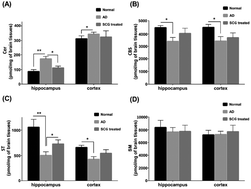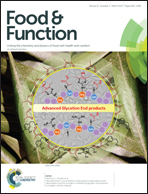Effects of dietary glucocerebrosides from sea cucumber on the brain sphingolipid profiles of mouse models of Alzheimer's disease†
Abstract
Herein, we investigated the potential relationship between sphingolipids and Alzheimer's disease (AD) with special attention to the relationship between dietary sea cucumber glucocerebrosides (SCGs) and sphingolipid metabolism. We assessed animal behavior using the Morris water maze test, determined Aβ1-42 concentration in the hippocampus using ELISA, and assessed the sphingolipid profile of the hippocampus and the cortex in normal mice (SAMR1), AD mice (SAMP8), and AD mice (SAMP8) fed with SCG using liquid chromatography-triple quadrupole mass spectrometry. We found that the SAMP8 mice had impaired memory and an SCG diet significantly rescued spatial memory deficits in these mice. As expected, we found that the profiles of sphingolipid species and the levels of total cerebrosides (CBS), ceramides (Cer), and sulfatides (ST) were significantly different in both the hippocampus and the cortex between the three groups; moreover, there were significantly lower ST levels and higher Cer and CBS levels in these regions in the SAMP8 mice. In the AD-SCG group, Cer and ST levels were altered only in the hippocampus, in contrast to the AD group. The major molecular species ST (d18:1-C24:1) and Cer (d18:1/18:0) were especially different between those of the two groups. Unexpectedly, sphingolipid profiles, including the nonhydroxylated fatty acid-ST/hydroxylated fatty acid-ST, very long fatty acid-galactocerebroside/long fatty acid-galactocerebroside, nonhydroxylated fatty acid-galactocerebroside/hydroxylated fatty acid-galactocerebroside and galactocerebroside/glucocerebroside ratios, were affected by AD. Thus, the ST and Cer levels and the profiles of sphingolipid species in the AD-SCG group were significantly different compared to those of the AD model group. Therefore, SCG has potential ameliorative effects in AD, and exogenous sphingolipid intake may potentially influence sphingolipid metabolism in vivo.



 Please wait while we load your content...
Please wait while we load your content...